
From the Hayward and the ICA to the Royal Academy, and from the public to the private sector, Angus Stewart compares and contrasts the qualities of works on show in London.
The British Art Show at The Hayward Gallery should be lively – there are 39 artists. It is, according to the Southbank Centre, recognised as the most ambitious and influential exhibition of contemporary British Art. We must hope this claim isn’t true. For if it is, we should be in mourning.
I’ve been often and have seen no sign of enjoyment, surprise, or admiration. On the contrary, the visitors are lackadaisical, apathetic or bemused and disorientated. Those I questioned were either harshly critical or blasé.
However, at the Royal Academy the drawings by Jean-Antoine Watteau are giving the public palpable delight. The viewers move slowly, they pause, they look, and they move away with regret, that regret tempered by their anticipation of more masterpieces to come.
While the silence at the Hayward is discomfiting, the hum at the Royal Academy is warm and harmonious. The few at the Hayward are awkward and ill-at-ease; the Academy’s guests are happily sharing a mutually satisfying dalliance.
The British Art Show opened last year in Nottingham and after London will visit Glasgow (Centre for Contemporary Art, May 28th – August 21st) and Plymouth (Arts Centre, September 17th – December 4th). The cost involved in these state-funded shenanigans doesn’t bear thought. Indeed, if the coalition wished to justify cutting the Arts Council budget, this sad show is one reason.
Being HOT, over the past fifty years ART has consumed state funds as never before. Museums, galleries and performance venues have popped up like fungi following on rain. Each growth has its apologists, and each upholder champions a particular art form, claiming it fulfills a need. More like the need is invented to content those who patronise or administer art and artists.
Consequently, instead of bringing society together, the purpose of ancient Greek theatre, the modern obsession with individualism centred on the self (of the artist and/or the art) fractures the encompassing community. In the seventies an American in Paris passed me an invitation to a gallery showing an oil painting and several drawings by Jean-Antoine Watteau (1684-1721). I was not taken by the oil, but I was captivated by the chalk drawings. For within them the chalk marks were placed, shaped and adjusted with such precision that reality was subsumed in Watteau’s invention. I was persuaded that the fanciful and faerie-like was as real as the rising up and the setting down of the sun. Watteau, apparently without great effort, could record the mundane as if it is truly miraculous.
The peculiarities of the first drawings I saw are beyond recall, but my pleasure at Watteau’s artistry was reignited when I saw his eighty-eight works in the Royal Academy’s Sackler Galleries. The Shipwreck is inexplicable, a tumult of water and wind; a magnet to the eye, a tease to the brain. Here and throughout his work Watteau is obsessed with detail, hands are placed as visual punctuation, to indicate distance, presence and association. The multitude of heads he studied, and the faces precisely observed and faithfully sketched, all convey subtle variations of temper and intelligence.
The Watteau paradox is simple; he saw directly into human psyche and did not flinch from its reality. But when he drew, he left pain, suffering and decay aside. In his day, his work was what we might now reasonably call outsider art. His temperament was not submissive, nor was he subject to external discipline. His biographer, Edme-François Gersaint, wrote: ‘His character was anxious and volatile; he stood by his wishes, was a libertine intellectually but was sober of habit, impatient, shy, cold and awkward in manner, discreet and reserved with strangers, a good but difficult friend, misanthropic, a shrewd and biting critic, always dissatisfied with himself and others and slow to forgive. He spoke little but well.’
On examination Watteau is an artist outside tradition, rather like Turner. Like Turner he was involved with the theatre, and like Turner he was stubborn and had a particular sense, one concomitantly sweet and sour, of himself and of his fellows. Watteau portrayed dalliance as grace, but we are shown that under the gently rippling surface the buttocks grind like millstones.
The catalogue, by Pierre Rosenberg and Louis-Antoine Prat, is a joy to behold and an education to absorb (£22.95). The drawings and the text make happy neighbours. As it was Watteau’s habit to collect his drawings in bound volumes the catalogue reader will see the sketches moving as the pages turn. Although the varied use of chalk is flattened, the original’s scale altered, what is revealed is Watteau’s mastery of space and his awareness of the relationship between human forms.
Concurrently there are ten oil paintings by Watteau, on canvas or panel, on show at the Wallace Collection. They date from 1710 to 1718 and are shown in the context of the collection’s 18th century works. Watteau influenced his own contemporaries and his heirs. In Watteau’s day drawings did not require a story, but paintings were rated on their plot. So Watteau, always the innovator, spawned the fête galante, a term as meaningful as it is meaningless. A fête galante takes place in the open and records a delightful social gathering wherein the characters sport, play and philander. Almost every figure within these paintings is ambiguous in posture, in tone, and in motive. The viewer would profit from a vade mecum. Fortunately an excellent guide is to hand: Watteau at the Wallace Collection by Christoph Martin Vogtherr (£25).

Like Watteau, Nathaniel Mellors has work on show in two London venues, at the Hayward and the ICA (both funded by Arts Council England). The difference between the two artists is great, for Mellors is an impresario; he conceives a product, writes its storyline, evolves its appearance, conducts its manufacture and orchestrates its promotion. The difference in the ‘facture’ of each man could hardly be greater. Watteau was a soloist, he created with his hands and chalks. Mellors is a collaborator. Their work is as different as their working practice.
Mellors’ concepts are constructs, the result of divers skills and techniques. He is one of the thirty-nine artists at the Hayward. He is represented by Matt’s Gallery, which is funded by the Arts Council to support artists ‘… to take risks, test their limits and surprise even their own intentions’. Really! Should the taxpayer afford such indulgence?
The following extracts are culled from Mellors’ exhibition handouts. Like the costs of his gallery, we taxpayers foot his bills. “‘Our house’ opens with the arrival of a hulking male figure at an English country house. The occupants, a wealthy bohemian family, initially fail to recognise him as human and dub him ‘The Object’… it becomes apparent The Object controls language in the house, roving its rooms at night in search of books that he devours and excretes as odd, foul-smelling sculptures.” (Hayward Gallery, 2011)
“Mellors’s distinctive body of work combines video, sculpture and writing and explores the complex relationship between language and power. His absurdist, humorous narratives reveal a penchant for satire and the grotesque.” (ICA, 2011, until May 15th) Grotesque and absurd are good words to describe the exhibition as a whole. Nevertheless I admire Mellors and many of his peers for what they have achieved. I applaud their ability to make what they wish a reality.
Mellors claims to have been influenced by Pier Paolo Pasolini (1922-1975), particularly by his film Salò (The 120 Days of Sodom). Possibly he was, but I doubt he benefited. For Pasolini was very Italian while Mellors is inescapably Anglo-Saxon. Mellors has roast beef sensibilities; his films are leisurely, haphazard and wearisome. They suggest an intermingling of the bizarre with Midsomer Murders and Bulldog Drummond. Possibly, overall, it is the Britishness of the artworks that is so depressing. Perhaps as a society the British have forgotten how to dance.
However the Royal Academy can pirouette on a pinhead; it reinvents itself several times each year. The Academy’s events are various and sometimes delightfully unexpected. The Arts Council, however, is encumbered by its past. As has often been reported in this publication, its behaviour has frequently been injudicious. The latest allocations and cuts ensure that the appetite of the wealthy sophisticate will be sated. So while extravagance will continue for the favoured, the seedbeds will be left to chance. The coalition would do well to close the Arts Council, and to sell or allocate its collection. Art will survive, it flows as freely as water – the country does not need extravagance, it needs individuals, like Watteau who made much from little.
The Jackdaw May-Jun 2011
